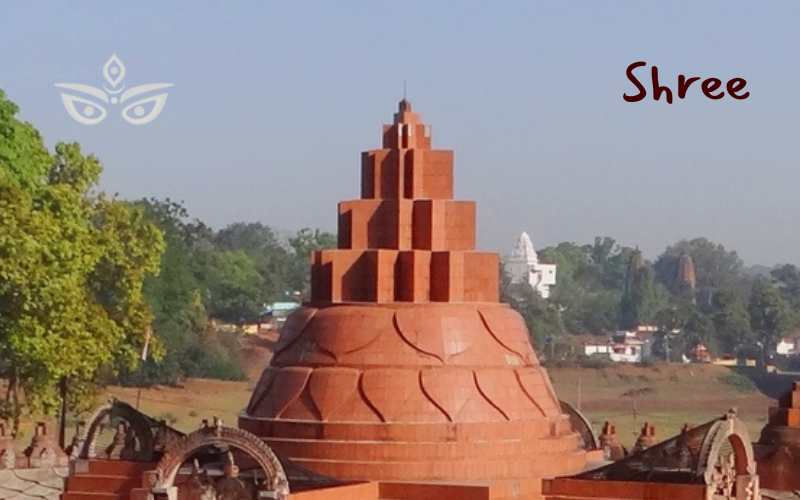Sadhguru says during Navratri Sadhguru Sannidhyan that Meditating on the Sri Yantra during Sharad Navratri is to embrace the cosmic womb where creation and consciousness intertwine. Each layer of the Sri Yantra reveals the unfolding of the universe within your consciousness.

Article | October 10, 2024

Sadhguru: Sharad Navratri, one of the most auspicious periods in the Hindu calendar, is a celebration of the Divine Mother, Durga, and her victory over the forces of ignorance and illusion. This is The Mystical Connection between Sri Yantra and Sharad Navratri. It is a time of deep reverence, where devotees embark on a spiritual journey to connect with the cosmic feminine energy, also known as Shakti. This festival is not just a ritualistic practice but a profound opportunity to align with the cosmic rhythms and explore the depths of consciousness.
Amid this spiritual fervour, one of the most potent and transformative practices is the meditation on the Sri Yantra—an ancient geometric symbol considered the embodiment of the universe itself. To meditate on the Sri Yantra during Sharad Navratri is to step into the womb of creation, a sacred space where the divine feminine energy creates and sustains the universe. This article explores the profound symbolism of the Sri Yantra, the significance of Sharad Navratri, and how meditating on the Sri Yantra during this time leads to an experience of the unfolding of the universe within one's consciousness.
Sharad Navratri unlocks the divine feminine power, allowing you to witness the cosmic dance within.
The Sacred Geometry of the Sri Yantra: A Map of Creation
The Sri Yantra, also known as the Sri Chakra, is a complex and precise geometrical diagram that consists of nine interlocking triangles. These triangles are arranged in such a way that they form 43 smaller triangles, creating a powerful symbol of the universe. The central point (Bindu) of the Sri Yantra represents the source of all creation—the singularity from which all existence emerges. The outermost boundary, known as the Bhupura, symbolizes the physical world and the material plane.
The nine interlocking triangles represent the interplay of the masculine and feminine energies in the cosmos. Four upward-pointing triangles symbolize Shiva, the divine masculine, and five downward-pointing triangles represent Shakti, the divine feminine. The interpenetration of these energies reflects the non-dual nature of existence—where creation and dissolution, expansion and contraction, are in a constant dance of balance.
When one meditates on the Sri Yantra, they are essentially meditating on the structure of the universe. Each layer, from the outermost boundary to the central bindu, corresponds to different levels of consciousness, from the material to the spiritual. By focusing on this sacred geometry, one is drawn into the deeper dimensions of existence, beyond the physical, into the subtle and causal realms.
Each night of Navratri offers a new facet of the Divine Mother, guiding us deeper into the layers of our own consciousness.
Sharad Navratri: The Cosmic Dance of Shakti
Sharad Navratri celebrated during the autumn season, is dedicated to the nine forms of Durga, the goddess who embodies the cosmic power of Shakti. Each of the nine nights (Navratri) is dedicated to a different form of the goddess, representing the various aspects of her energy—from nurturing and protective to fierce and transformative.
This period is not just a religious observance but a cosmic event. It is said that during Sharad Navratri, the veil between the material and spiritual worlds becomes thin, allowing for deeper spiritual practice and connection to the divine. The goddess, in her various forms, is invoked to help devotees overcome inner and outer obstacles, purify their minds, and ultimately lead them to self-realization.
The energy of Shakti, which is in full force during Navratri, is also symbolized in the Sri Yantra. Just as Durga is the creative and destructive force of the universe, the Sri Yantra represents the cyclical nature of creation, preservation, and dissolution. Meditating on the Sri Yantra during this period aligns one’s consciousness with the cosmic Shakti, allowing for a profound transformation of body, mind, and soul.
Entering the Womb of Creation through Sri Yantra Meditation
To meditate on the Sri Yantra during Sharad Navratri is akin to entering the womb of creation itself. The womb (garbha), in both physical and spiritual contexts, represents a sacred space of potential, growth, and transformation. In the Sri Yantra, the central Bindu is often seen as this cosmic womb—an infinitesimal point from which the entire universe unfolds.
The practice of meditating on the Sri Yantra begins with visualizing or gazing at the outermost square, the Bhupura. This square is symbolic of the material world, the physical reality in which we live. As the mind becomes still, the practitioner is guided inward, progressing through the layers of triangles, circles, and lotus petals, each representing different aspects of creation, energy, and consciousness.
To meditate on the Sri Yantra is to witness the unfolding of the universe within, revealing the interconnectedness of all life.
The journey from the outer square to the central Bindu is not just a movement through space but a journey through layers of existence—from the gross physical body to the subtle mind and intellect, and finally, to the pure consciousness that lies at the core of all creation. As one moves inward through meditation, they are entering the very womb of the universe, where creation is not a distant event in time but an ever-present unfolding within the self.
The Unfolding of the Universe within Consciousness
One of the most profound experiences of meditating on the Sri Yantra during Sharad Navratri is the realization that the universe is not something external to us—it is something that unfolds within our own consciousness. The complex geometry of the Sri Yantra mirrors the structure of the cosmos, but it also mirrors the structure of the mind and the individual soul. Just as the universe unfolds from a single point of energy, so too does the individual soul expand from the central point of consciousness within.
As the practitioner meditates on the Sri Yantra, they may begin to experience a shift in their perception of reality. The outer world, with all its complexity and multiplicity, starts to dissolve into a unified field of energy. The dualities of life—light and dark, joy and sorrow, creation and destruction—are seen not as opposites but as complementary aspects of a single, unified reality. This is the experience of non-duality (Advaita), where the self and the universe are no longer separate entities but one continuous flow of consciousness.
During Sharad Navratri, the energy of Shakti is at its peak, and this cosmic power facilitates the inner unfolding of the universe. As one meditates on the Sri Yantra, they tap into this divine energy, and the boundaries of the self begin to dissolve. The practitioner witnesses the universe not as an observer but as a participant in its creation, preservation, and dissolution. In this state of expanded awareness, the meditator experiences the unfolding of the universe as an intimate, personal event—an eternal process that is happening within and around them simultaneously.
In the cosmic dance of creation, we are not mere observers but active participants, experiencing the unity of existence.
The Symbolism of Creation in the Sri Yantra
The Sri Yantra, as a geometric representation of the cosmos, holds deep symbolism related to creation. Each element of the Yantra corresponds to different aspects of the universe's unfolding:
The Bhupura: The outermost square represents the earth element and the material world. It is the foundation of all creation, the solid ground upon which life manifests. In meditation, the Bhupura symbolizes the grounding of one’s consciousness in the present moment, anchoring the mind in the here and now before beginning the inward journey.
The Lotus Petals (Padma): Inside the Bhupura are layers of lotus petals, which represent the unfolding of consciousness. Just as a lotus flower blooms, the individual soul (Atma) blossoms as it moves closer to the divine source. The lotus also symbolizes purity, as it grows in muddy water yet remains untouched by the mud. In Sri Yantra meditation, the lotus petals guide the practitioner inward toward higher states of consciousness.
The Triangles: The interlocking triangles in the Sri Yantra represent the dynamic interplay between the masculine (Shiva) and feminine (Shakti) energies of the universe. This interplay is the very essence of creation. In the practice of Sri Yantra meditation, these triangles symbolize the balance of opposites within the individual—action and stillness, energy and consciousness, form and formlessness.
The Bindu: The central point of the Sri Yantra, the Bindu, is the source of all creation. It is the point of pure potential from which the universe unfolds. In meditation, the bindu is where the practitioner merges with the ultimate reality, transcending the limitations of time, space, and individuality. It is the experience of oneness with the cosmos, the realization that all of creation emerges from and returns to this single point of consciousness.
Sharad Navratri is a time when the veil between the material and spiritual worlds thins, inviting profound transformation.
The Transformative Power of Sri Yantra Meditation during Sharad Navratri
The practice of meditating on the Sri Yantra during Sharad Navratri is a powerful tool for transformation. As the individual meditates on the sacred geometry, they begin to shed the layers of the ego and the mind that obscure their true nature. The nine nights of Navratri correspond to the nine stages of spiritual purification, where the individual progressively moves closer to the divine.
Each night, as the devotee worships a different form of Durga, they also meditate on different aspects of the Sri Yantra, purifying their mind and heart. This process of purification allows the practitioner to move beyond the limitations of the physical world and tap into the infinite potential of the cosmos. The energy of Shakti, in its most potent form during Navratri, supports this transformation, guiding the individual from ignorance to enlightenment, from separation to unity.
The interlocking triangles of the Sri Yantra reflect the harmony of opposites, a reminder that creation is a balanced dance.
Becoming a Witness to the Cosmic Dance
To meditate on the Sri Yantra during Sharad Navratri is to participate in the cosmic dance of creation. It is to step into the sacred womb of the universe, where all things are born, sustained, and eventually dissolved. This meditation is not just a practice of focusing the mind; it is a profound spiritual journey that reveals the interconnectedness of all existence.
As the practitioner moves inward through the layers of the Sri Yantra, they witness the unfolding of the universe within their own consciousness. They come to realize that the cosmos is not a distant or abstract concept—it is an intimate part of their own being. In this state of expanded awareness, the meditator becomes a witness to the divine play of creation, experiencing the infinite possibilities of the universe unfolding within and around them.
During Sharad Navratri, the energy of the Divine Mother is at its peak, and meditating on the Sri Yantra allows one to merge with this cosmic energy. It is a transformative practice that dissolves the boundaries of the self, allowing the practitioner to experience the unity of all existence. Through this meditation, one steps into the womb of creation and witnesses the eternal unfolding of the universe, a journey that leads to the ultimate realization of oneness with the divine.



Comments